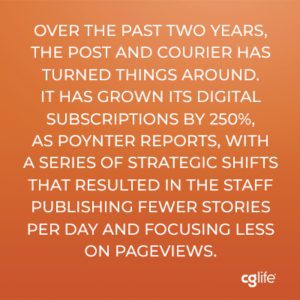“Owned media.” That’s another way to frame content marketing. Instead of trying to earn coverage through public relations or buy coverage through paid advertising, content marketing seeks to cultivate and nurture its own audience. We’re not marketing at them ; this is inbound marketing. By producing relevant and informative content, we’re drawing new users in. With this backdrop, it’s easy to see the parallels between the work we do and the work performed by professional publications. That’s why a recent article on the transformation of a local news outlet caught my eye. The lessons translate well (in fact, we’ve done the translating for you). And I have to say, the engagement stats are impressive.  The case study at hand is the Charleston Post and Courier ; the largest newspaper in South Carolina. It was the product of a merger of three publications — all of which were founded in the 1800s. But like almost all traditional media outlets, they’ve encountered tough times in the 21st Century. In 2008 and 2009, more than 100 employees were laid off in a series of restructures geared towards one thing: survival. But over the past two years, the Post and Courier has turned things around. It has grown its digital subscriptions by 250%, as Poynter reports, with a series of strategic shifts that resulted in the staff publishing fewer stories per day and focusing less on pageviews. Below is a breakdown of some of their tactics, with notes on how you can apply these to your content marketing program. TL;DR? No problem — good managers delegate. Assign your content marketing to CG Life.
The case study at hand is the Charleston Post and Courier ; the largest newspaper in South Carolina. It was the product of a merger of three publications — all of which were founded in the 1800s. But like almost all traditional media outlets, they’ve encountered tough times in the 21st Century. In 2008 and 2009, more than 100 employees were laid off in a series of restructures geared towards one thing: survival. But over the past two years, the Post and Courier has turned things around. It has grown its digital subscriptions by 250%, as Poynter reports, with a series of strategic shifts that resulted in the staff publishing fewer stories per day and focusing less on pageviews. Below is a breakdown of some of their tactics, with notes on how you can apply these to your content marketing program. TL;DR? No problem — good managers delegate. Assign your content marketing to CG Life.
Don’t Shy Away from the Stats
Here at CG Life, we have a dedicated digital team. They’re rockstars when it comes to implementing sophisticated digital campaigns and tracking and analyzing all the available data. As such, it’s tempting to rely on them for everything digital — but that would be a major mistake. We all need to lean into the data and have a baseline knowledge of how to interpret it. This was an important shift for the Post and Courier team, as Poynter calls out.
“The entire newsroom learned and started using Slack and Parse.ly. Staffers moved away from automated newsletters into curated ones.” __
Basically, they all went digital. Everyone started engaging with the analytics (through Parse.ly) and collaborating more closely across the office (via Slack). Instead of expecting someone else to track the data, they all got more involved and established their own feedback loops…__
“If a story didn’t have 500 unique visitors and at least 1.2 minutes of engaged time, it got reevaluated. That doesn’t mean those kinds of stories just stopped. Instead, staff looked at how the story was written, the headline, the keywords for search and other dials they could adjust. If after all that, if those pieces still didn’t hit those minimum goals, the newsroom stopped doing them.”
Information is power, as they say. And in this case, it empowered the reporters to tinker with their topics, their headlines, and their newsletter to be constantly evolving and improving. As marketing writers, we need to do the same. Need help establishing a digital platform that your company can understand and own? Let’s work together.
Think Critically About What You’re Tracking
Understanding how to use key digital platforms allowed each of the writers to iterate and improve their approach. But there’s another benefit to sharing the knowledge across your team. The publication came to realize that they were tracking the wrong statistics. When they first moved to digital, they focused exclusively on clicks and pageviews. That was how they gauged success. As part of the Post and Courier’s transformation:
“Staff started focusing on analytics that lead to subscriptions: time spent and engaged minutes.”
Digital teams do their best to set-up relevant metrics and programs, but we need to meet them halfway. There are specific challenges and nuances in our respective fields that won’t be on their radar unless we put them there. By empowering each of the employees to think critically about their goals and metrics, the Post and Courier was able to build a tracking system that was more closely aligned with the company’s work and a real measure of success. Your team should do the same, to ensure your audience is relevant and that they’re spending quality time on your website.
Less is More
Less is more is another principle that we’re working towards at CG Life: Not churning out content for content’s sake. Everything should be purposeful and original. As part of its strategic overhaul, the Post and Courier moved from publishing somewhere between 50 and 65 stories per day to just 30. According to the outlet’s Executive Editor Mitch Pugh, they’ve still got a ways to go:
“We probably need to be more like 21— that’s what the data tells us.”
By cutting down on the frequency of articles, the reporters were able to deep dive into more complex and complete stories. They went beyond compiling the news and facts to adding different perspectives and context around the topic. This original insight and macro commentary seems to be what the audience reads.
“Blow-by-blow city council stories do OK, for instance, but when the newsroom takes a step back and talks about why something matters, what it means and what’s next, more people read it.”
Whether you’re a CRO, a drug developer, or a biotech incubator; you can replicate this approach. Tap into the knowledge you have internally and produce something special and unique. You may know key opinion leaders, you likely attend key conferences — heck you might even have a proprietary database of customer knowledge that grants you special insight. Dig deep into these reservoirs to avoid churning out the same superficial content that you see elsewhere. Wow, these people really know their stuff when it comes to content marketing: I want to learn more.
